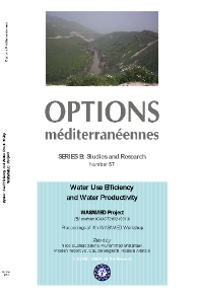| Article précédent | p. 211-216 | Article suivant |
Use of the heat dissipation technique for estimating the transpiration of olive trees
The objective of this work is to investigate the practicality of using the more recently developed heat dissipation method for sap flow measurements of olive trees. To this end an experiment has been carried out on twelve year olive trees grown in central Tunisia. Four trees were selected for transpiration monitoring under changing water regime. On each tree, three probes placed at different exposures were used, North (N), South East (SE) and South West (SW). Measurements of all twelve probes were collected every thirty minutes, over a complete growing season. For the 95 days, during which all sensors were operational, daily values of sap flow density vary from 10 to 120 l dm-2 d-1, about one to five ratio is observed between sensors. The mean value of sensors installed on each tree is highly correlated with the 12 sensors average values. When considering each direction separately, it seems that flux density is not related to the direction of the sensor, correlation between sap flow density of a sensor placed in a given direction and average value within that direction is variable. Variability of sap flow density between probes seems to be related rather to sapwood area heterogeneity. Regression equations relating sap flow density of each probe to the 12 probes average values were established and correlation coefficient exceeds 0.85. With such calibrated equations, estimation of olive tree transpiration from a single probe and reconstitution of missing data becomes possible.
- [ Afficher ]
- [ Télécharger ]
- [ Exporter la citation ]
Vous pouvez télécharger la citation au format :
- [ Imprimer ]
-
Mots-clés
MESURE, METHODE, MODELE, OLEA EUROPAEA, TRANSLOCATION, TRANSPIRATIONCiter cet article
Abid Karray J., Masmoudi M.M., Luc J.P., Ben Mechlia N. Use of the heat dissipation technique for estimating the transpiration of olive trees. In : Lamaddalena N. (ed.), Shatanawi M. (ed.), Todorovic M. (ed.), Bogliotti C. (ed.), Albrizio R. (ed.). Water use efficiency and water productivity: WASAMED project. Bari : CIHEAM, 2007. p. 211-216. (Options Méditerranéennes : Série B. Etudes et Recherches; n. 57). 4. WASAMED (WAter SAving in MEDiterranean agriculture) Workshop, 2005/09/30-2005/10/04, Amman (Jordan). http://om.ciheam.org/om/pdf/b57/00800789.pdf



